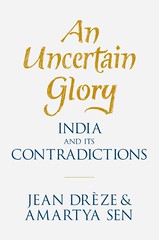'An uncertain glory - India and its contradictions' is a book which analyses the decision-making process in India after economic reforms and the impact of those decisions. It also analyses the attention given to under-privileged population by media and discussion forums. According to the author, in the real democracy, opinion-forming bodies discuss the whole population, not just a sub-section. The authors, Amartya Sen – a distinguished economist and Nobel laureate – and Jean Drèze, an economist living in India for more than 30 years now, have argued for a more active role of governments. They also argue for using a greater part of the revenues, generated by the high rate of growth of the Indian economy in last two decades, for welfare expenditure. While advocating that, the authors have given the example of 'Asian economic giants' who did not have very good social indicators before their economic boom but caught up in an impressive way. The authors focus mostly on China and Bangladesh for most of the comparative statistics but other countries have also been mentioned.
India's performance in most of the social indicators - such as those related to health, education, and poverty - has not been up to the expectation as was expected after seeing the experience of many other economies which 'opened up' in the later half of the twentieth century. Still, a large part of the country is not able to get the elementary education and many of the villages are situated too far from a school, a PHC or a PDS center (fair price shop). The authors bring out the neglect in the schemes with social benefits and even if schemes were initiated, they were implemented in a very inefficient manner.
One thing that stands out throughout the book is the advocacy of government as the provider of the amenities such as education, public health and curative health care (in contrast to public health care which is preventive in nature). The authors also advocate for a proactive role of government and ask private players to act as supplements, not as primary players. To support this public policy position, they give the example of many countries of Asia which started growing in last few decades but have succeeded in providing these amenities quite satisfactorily. The authors also state that most of the Europe and the US attained the high ranking in these parameters because of clear government interventions. While one may agree with the authors in many arguments given the 'public goods' nature of these amenities, the experience of India has not been good as far as implementation of government welfare schemes is concerned. Because of the rampant corruption, leakage, and bureaucratic inefficiency, schemes have not benefitted the intended public as might have been expected from them. With no clear solution to this malaise, any new scheme is bound to succeed only partially, if it succeeds at all.
The authors focus on the public discourse in India and the neglect therein of under-privileged groups. According to the authors, the word ‘aam aadmi’ - meaning common man - has become synonymous with a section of the middle class which is a small fraction of the entire population but is very much represented in the media. Any attempt to curtail subsidies given to this group are met with wide protests and governments back down easily. According to the authors, socially and economically deprived sections of society are yet to be vociferous in their demands and when that happens, then only accountability can be ensured in our democracy. The authors also speak against too much focus given to the absolute rate of growth of the economy. While growth is good for an economy as it generates avenues of the employment, brings many people out of poverty and generates revenues which can be spent on public goods, it should not be seen as an end in itself, but as means to achieve greater social equality.
Before reading this book, I read the book "India's Tryst with Destiny" by Bhagwati and Panagariya and ideological differences between these two books is quite apparent. Bhagwati and Panagariya advocate a free-market based libertarian approach with a greater role of private players given the failure of governments at various levels to provide the basic amenities, whereas Sen and Dreze argue for a government led modern liberal approach given the public goods nature of basic amenities. Which approach will work cannot be said until we try one and see the results. Both these approaches have been successful in few countries. It may not be possible to try both approaches and see which one works because of the non-reversible nature of such policy decisions. This book is a passionate analysis of what economic achievements India is lacking despite being entitled to them because of the consistently high rate of growth.

